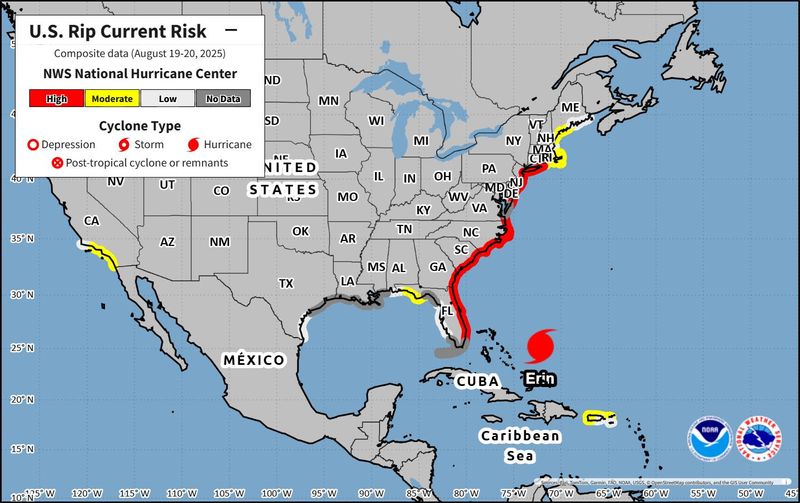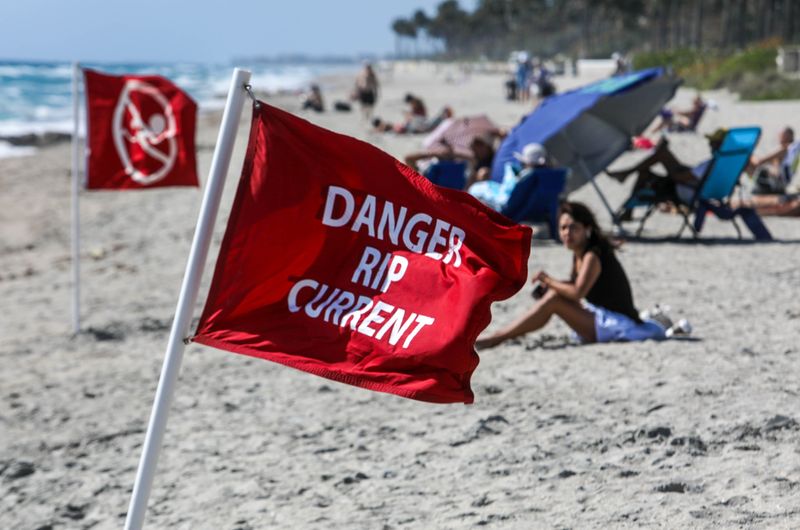

Lifeguards have rescued dozens of people from the churning waters along East Coast beaches even as Hurricane Erin moves hundreds of miles offshore.
Authorities in North Carolina said about 60 people had to be rescued from rip currents at Wrightsville Beach, prompting a no-swim order through the rest of the week, according to the Wilmington Star-News, part of the USA TODAY Network.
Another person was rescued from rip currents at a South Carolina beach, and a dozen rip currents were reported at South Carolina and Georgia beaches Aug. 18, the National Weather Service in Charleston, South Carolina, said.
Erin has made conditions prime along East Coast beaches for life-threatening rip currents that can catch people off guard, National Hurricane Center Director Mike Brennan said in a news briefing over the weekend. Weather conditions might look ideal for a beach trip, but dangerous rip currents can be hard to spot.
Rip currents threaten beaches along entire East Coast
The threat exists up and down the entire East Coast, hurricane forecasters said. Beaches as far north as Massachusetts are closed to swimmers because of rough surf. In Atlantic City, New Jersey, officials said beachgoers were restricted to getting knee-deep into the water and were prohibited from using boogie boards.
"The force of the rip currents and rough surf along the Atlantic coast this week is life-threatening. Hurricane Erin is producing a tremendous amount of energy that will create hazardous beach conditions from Florida to New England," said AccuWeather lead hurricane expert Alex DaSilva.
Brennan urged beachgoers to heed posted warnings and beach closures and swim only close to lifeguards.
"Rip currents can sweep even the best swimmers away from shore into deeper water," the National Weather Service in Charleston said Aug. 19 in a warning to South Carolina and Georgia.
How to stay safe from rip currents
Rip currents kill dozens in the United States every year, according to data from the National Oceanic and Atmospheric Administration. Since 2010, more than 800 people have died in rip current drownings. As of late July, at least 52 people died from surf zone dangers, nearly half of which were rip current drownings, the data shows.
A rip current is a fast-moving channel of water that flows away from the shore and can drag a swimmer out into the ocean. The narrow, strong currents flow quickly and perpendicular to the coastline.
Rip currents are so dangerous because they can catch swimmers off guard and cause them to panic while trying to swim to shore. The exertion causes fatigue before they are able to break free from the current, which continues to pull them out, experts say.
Officials say you should check for any warnings before entering the water and keep an eye on weather and water conditions. Always swim near a lifeguard.
If you do end up caught in a rip current, try to remain calm. The current won't pull you under, it will just pull you away from the shore. Don't swim against the current, because you'll risk tiring yourself out; instead, swim parallel to the shore and then swim back to land at an angle once you're free of the current.
If you see someone else struggling in a rip current, you should try to get help from a lifeguard, according to the NOAA's Rip Current Survival Guide. You can also throw something that floats to the person while you find a lifeguard. If there is no lifeguard on duty, call 911. Do not enter the water to try to help; experts say people who try to help often get caught in rip currents themselves.
This article originally appeared on USA TODAY: Dozens rescued from rip currents as Hurricane Erin brings danger to East Coast beaches
Reporting by Jeanine Santucci, USA TODAY / USA TODAY
USA TODAY Network via Reuters Connect

 USA TODAY National
USA TODAY National
 WRAL News
WRAL News WCNC Charlotte Weather
WCNC Charlotte Weather The Greenville News
The Greenville News Daily Voice
Daily Voice Newsday
Newsday WYMT
WYMT KAKE
KAKE WMTV NBC15
WMTV NBC15 Blaze Media
Blaze Media Raw Story
Raw Story